
Set in 1936 Pittsburgh, The Piano Lesson by August Wilson explores the Charles family’s ancestral piano, carved with their ancestors’ images, symbolizing cultural heritage and identity.
Overview
The Piano Lesson, written by August Wilson, is a powerful exploration of family, history, and identity. Set in Pittsburgh in 1936, the play centers on the Charles family and their ancestral piano, carved with images of their enslaved ancestors. The piano becomes a symbol of their heritage and the source of conflict between siblings Berniece and Boy Willie. While Boy Willie wants to sell the piano to buy land, Berniece insists on preserving it as a connection to their past. This tension reflects broader themes of cultural identity, economic struggles, and the weight of history. The play is part of Wilson’s Pittsburgh Cycle and won the Pulitzer Prize, solidifying its place in American theater as a profound meditation on legacy and redemption. Its rich dialogue and layered characters bring the past and present into vivid conflict, making it a cornerstone of Wilson’s work.
Historical Background
The Piano Lesson, set in Pittsburgh in 1936, reflects the struggles of African Americans during the Great Migration and the post-slavery era. The play explores the legacy of slavery and racism through the Charles family’s ancestral piano, carved with images of their enslaved ancestors. August Wilson draws on the historical context of Black Americans’ fight for identity, economic stability, and cultural preservation. The piano serves as a tangible connection to the family’s past, embodying the sacrifices and resilience of their ancestors. Wilson’s work is part of his Pittsburgh Cycle, which chronicles the Black experience in America across decades. This play, in particular, highlights the tension between embracing heritage and pursuing progress in a society still grappling with racial inequality. It captures the essence of African American history and its enduring impact on families like the Charleses. The historical backdrop underscores the play’s themes of identity, redemption, and the weight of inherited trauma, making it a poignant reflection of America’s past and present.
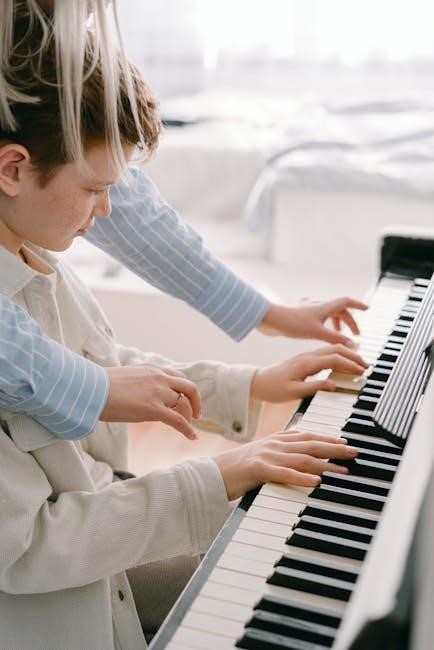
Major Themes
The play explores themes of cultural heritage, family legacy, and the struggle between past traditions and future aspirations, reflecting the complexities of identity and redemption.
The Struggle Between Past and Future
In The Piano Lesson, the conflict between Berniece and Boy Willie embodies the tension between preserving ancestral heritage and embracing progress. The piano, a symbol of their enslaved ancestors, represents the past, while Boy Willie’s desire to sell it for land signifies a future of economic freedom. Berniece, however, views the piano as a sacred family heirloom that connects them to their history and identity. This struggle reflects the broader African American experience of reconciling the weight of slavery’s legacy with the pursuit of a better life. Wilson uses this dichotomy to explore themes of identity, redemption, and the importance of cultural memory in shaping the future.
Cultural Heritage
In The Piano Lesson, the family piano serves as a powerful symbol of cultural heritage, carved with the images of the Charles family’s enslaved ancestors. This artifact embodies the history and legacy of the family, preserving their stories and struggles. The piano’s intricate carvings function as a visual narrative, connecting the present generation to their past. August Wilson uses the piano to highlight the importance of honoring one’s roots and understanding the value of cultural identity. The piano becomes a central element in the play, representing both the family’s collective memory and the broader African American experience of resilience and heritage. Through this symbol, Wilson underscores the necessity of preserving history to inform and enrich the future.
Family Dynamics
The complex family dynamics in The Piano Lesson are central to the play’s exploration of identity and heritage. Berniece and Boy Willie’s conflicting views over the piano reflect deeper familial tensions. Berniece, emotionally tied to the piano’s historical significance, resists selling it, while Boy Willie sees it as a means to secure a future. Their disagreements highlight generational and ideological divides within the Charles family. Doaker and Avery offer contrasting perspectives, with Doaker often mediating and Avery emphasizing spiritual guidance. The play portrays a family grappling with legacy, sacrifice, and the weight of ancestral history, illustrating how internal conflicts can both divide and ultimately strengthen familial bonds. Through these interactions, August Wilson explores the intricate web of love, resentment, and shared history that defines the Charles family.
Spiritual and Supernatural Elements
The Piano Lesson is deeply infused with spiritual and supernatural elements, which play a crucial role in exploring the characters’ connections to their past. The ghost of Robert Sutter, a white ancestor tied to the family’s history, is a significant supernatural presence, though unseen. This spectral figure symbolizes the lingering impact of slavery and racial oppression. Additionally, Avery’s ambition to become a preacher highlights the spiritual undertones, as he seeks to guide his family toward redemption. The piano itself is imbued with ancestral spirits, serving as a bridge between the living and the dead. These elements underscore the play’s themes of inherited trauma and the necessity of confronting the past to achieve spiritual liberation and healing. Wilson uses these motifs to emphasize the enduring legacy of slavery and its influence on the present.
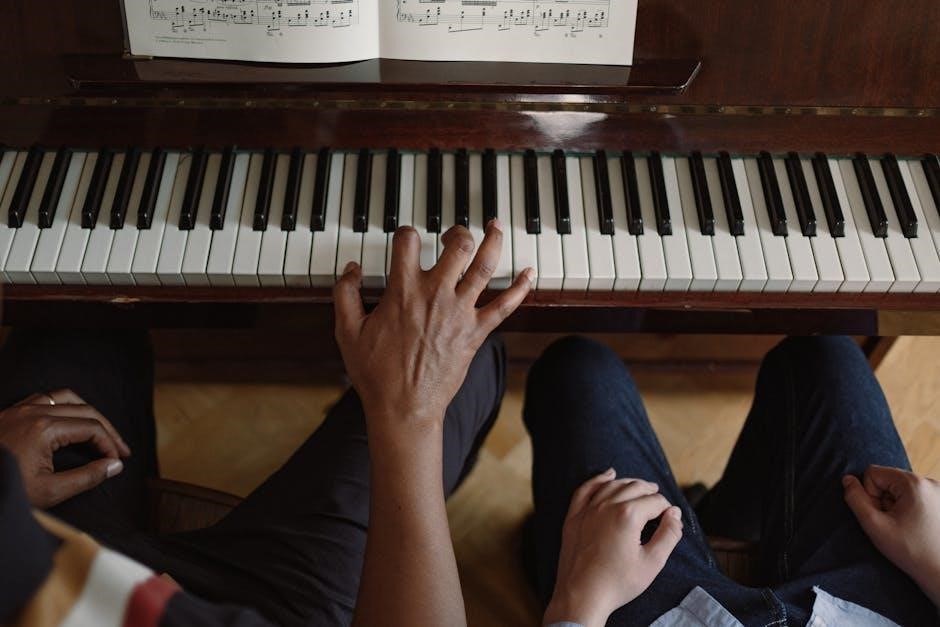
Symbolism
The piano, carved with ancestral images, symbolizes the family’s history, cultural identity, and spiritual connection. It embodies the legacy of slavery and the struggle for freedom.
The Piano as a Symbol
The piano in August Wilson’s The Piano Lesson serves as a powerful symbol of the Charles family’s history, cultural heritage, and spiritual identity. Carved with images of their enslaved ancestors, it represents the family’s connection to their past and the legacy of slavery. The piano becomes a source of conflict between Berniece and Boy Willie, reflecting their differing views on how to engage with their heritage. For Berniece, it is a sacred artifact that honors their ancestors, while Boy Willie sees it as a means to achieve economic freedom. The piano symbolizes the struggle between preserving cultural identity and embracing the future, making it a central element in the play’s exploration of identity, history, and redemption.
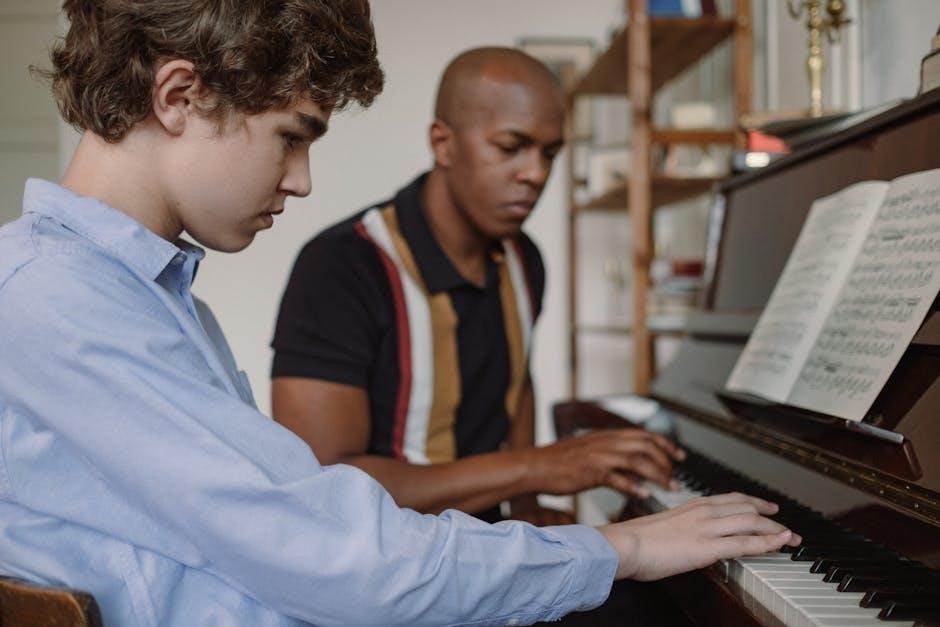
Characters
The play features complex characters like Berniece, Boy Willie, and Doaker, each representing different perspectives on family, heritage, and identity, driving the emotional core of the story.
Berniece
Berniece, the strong-willed sister of Boy Willie, is deeply protective of the family piano, seeing it as a connection to their ancestors and cultural heritage. Her resistance to selling the piano stems from a desire to preserve the past and honor her family’s history. Berniece’s emotional depth is revealed through her complex relationship with her brother and her lingering grief over her husband’s death. She embodies the struggle between tradition and progress, making her a central figure in the play’s exploration of identity and legacy. Her character highlights the emotional weight of the past and its impact on the present.
Boy Willie
Boy Willie, the dynamic and determined brother of Berniece, is driven by a desire to sell the family piano to buy land, symbolizing his pursuit of a better future. His decision reflects his belief in progress and self-improvement, often clashing with Berniece’s insistence on preserving their heritage. Boy Willie’s character represents the tension between tradition and modernity, as he views the piano as a means to achieve economic freedom rather than a relic of the past. His relentless determination and charismatic personality make him a central figure in the play’s conflict, highlighting themes of identity, family, and the struggle for a brighter tomorrow.
Doaker
Doaker, the uncle of Berniece and Boy Willie, serves as a calm and reflective presence in the Charles household. As a former railroad worker, he carries a deep understanding of the family’s history and the significance of the piano. His wise and observant nature makes him a mediator in the conflicts between his niece and nephew. Doaker’s stories and insights provide a bridge between the past and present, emphasizing the piano’s role as a cultural artifact. His quiet strength and loyalty to the family highlight his importance in maintaining unity amid tension. Through Doaker, Wilson underscores the value of preserving heritage while navigating the challenges of the present.
Other Characters
Other characters in The Piano Lesson play significant roles in shaping the narrative. Lymon, Boy Willie’s friend, brings optimism and a desire for a better life, highlighting themes of hope and struggle. Avery, a preacher, seeks to guide the family spiritually, emphasizing the importance of faith. Wining Boy, the uncle, provides wisdom and humor, offering a different perspective on the family’s history. Maretha, Berniece’s daughter, represents the future generation, underscoring the importance of legacy. The ghost of Robert Sutter symbolizes the haunting past, reminding the family of their history. Each character adds unique dimensions to the play’s exploration of identity, heritage, and the tension between past and future, collectively enriching the narrative and deepening its emotional resonance.

Style and Structure
August Wilson’s style in The Piano Lesson features rich, lyrical dialogue and a non-linear structure. His use of cyclical storytelling emphasizes themes of history and identity.
August Wilson’s Writing Style
August Wilson’s writing style in The Piano Lesson is lyrical and evocative, blending rich dialogue with a deep exploration of African American heritage. His use of non-linear storytelling weaves past and present, creating a layered narrative that reflects the characters’ connections to their history. Wilson’s prose is infused with poetic imagery and a musical rhythm, reminiscent of blues and jazz, adding emotional depth to the play. His characters are complex and multi-dimensional, often grappling with themes of identity, legacy, and cultural preservation. Wilson’s ability to craft vivid, immersive scenes makes his writing both powerful and thought-provoking, offering audiences a profound exploration of the African American experience.
Use of Dialogue
August Wilson masterfully employs dialogue in The Piano Lesson to reveal character depth and thematic richness. Conversations between Berniece, Boy Willie, and other characters are infused with emotional intensity, reflecting their inner struggles and cultural heritage. Wilson’s dialogue often carries a musical quality, echoing the rhythms of African American Vernacular English, which adds authenticity and vibrancy to the narrative. Through these exchanges, Wilson explores tensions between past and future, family dynamics, and the supernatural. The dialogue not only advances the plot but also serves as a vehicle for storytelling, preserving the history and legacy of the Charles family. This approach creates a dynamic interplay between characters, enriching the play’s emotional and cultural landscape.
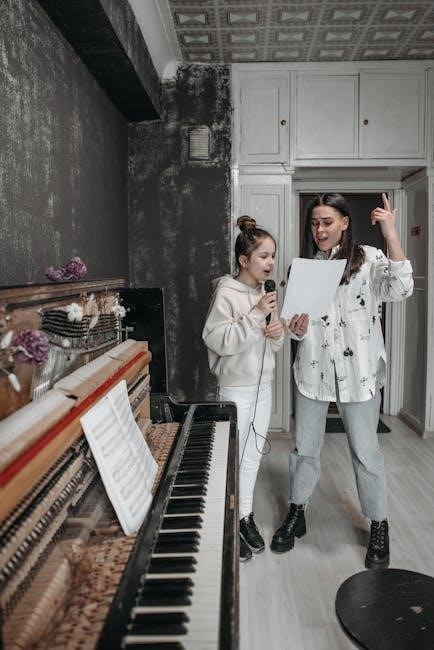
Play Structure
August Wilson’s The Piano Lesson is structured to reflect the cyclical nature of time and memory. The play unfolds in a single setting, the Charles family home, creating a sense of containment that amplifies the emotional intensity. Acts are divided to mark shifts in character dynamics and thematic focus, with each act building on the central conflict over the piano’s fate. Wilson’s use of non-linear storytelling, through characters’ recollections and ancestral spirits, adds depth and complexity. The structure mirrors the play’s themes of past and present colliding, allowing the audience to experience the family’s history alongside their current struggles. This cohesive framework ensures that every scene contributes to the overall narrative, culminating in a powerful resolution that honors both heritage and progress.
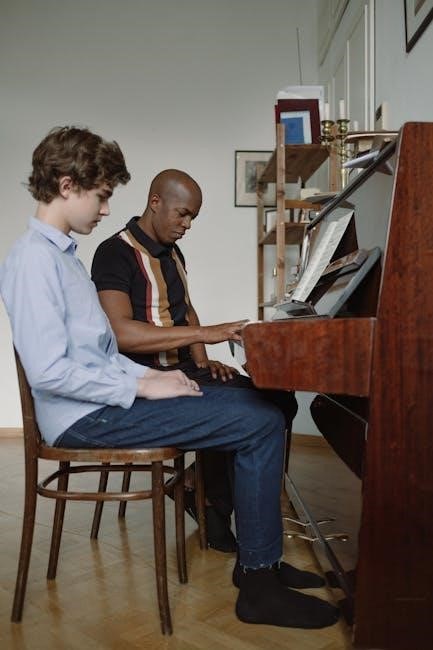
Themes Continued
The play delves into themes of justice, morality, and economic struggles, highlighting the characters’ quests for fairness and survival amidst societal pressures and ancestral legacies.
Redemption
In The Piano Lesson, redemption emerges as a central theme, particularly through the characters’ struggles to reconcile their past and present. The piano, carved with ancestral images, serves as a catalyst for redemption, symbolizing the need to confront and honor the family’s history. Berniece’s reluctance to part with the piano reflects her desire to preserve their cultural legacy, while Boy Willie’s wish to sell it represents a longing to break free from the past. The play suggests that redemption lies in acknowledging and embracing the ancestors’ stories, allowing the characters to heal and move forward. This theme underscores the importance of facing historical traumas to achieve spiritual and emotional liberation.
Identity
In The Piano Lesson, identity is a central theme, explored through the characters’ connection to their ancestral heritage. The piano, carved with images of their enslaved ancestors, becomes a symbol of the family’s history and cultural identity. Berniece’s attachment to the piano reflects her desire to preserve this legacy, while Boy Willie’s wish to sell it symbolizes his attempt to break free from the past and forge a new identity. The play highlights the struggle between honoring one’s roots and embracing change, a common experience for African Americans in the early 20th century. Through this conflict, Wilson examines how identity is shaped by history, family, and the quest for self-determination in a world marked by racial and economic challenges.
Justice and Morality
In The Piano Lesson, justice and morality are intertwined with the family’s history and their ancestral piano. The piano, carved with images of enslaved ancestors, serves as a reminder of the injustices of slavery and the moral debt owed to the past. Berniece’s refusal to sell the piano reflects her commitment to preserving their legacy and honoring the sacrifices of their ancestors. Conversely, Boy Willie’s desire to sell it for land symbolizes a pragmatic approach to achieving economic justice in a racially oppressive society. The play raises questions about what constitutes moral justice: preserving cultural heritage or seeking material freedom. This tension underscores the broader struggle for African Americans to reconcile their past with their future. The ghost of Robert Sutter, a former slave owner, further emphasizes the unresolved moral reckoning of slavery’s legacy.

Reception and Impact
The Piano Lesson received widespread critical acclaim, earning August Wilson the Pulitzer Prize for Drama in 1990. It is celebrated for its profound exploration of cultural identity, family, and history, solidifying Wilson’s reputation as a leading voice in American theater. The play’s emotional depth and historical resonance have made it a cornerstone of African American literary canon, with its themes continuing to resonate today.
Critical Acclaim
The Piano Lesson garnered widespread critical acclaim upon its debut in 1987. The play solidified August Wilson’s reputation as a masterful storyteller, earning him the Pulitzer Prize for Drama in 1990. Critics praised its nuanced exploration of family, heritage, and identity, with many highlighting its emotional depth and historical significance. The play’s ability to weave together personal and collective histories resonated deeply with audiences and scholars alike. Its portrayal of African American experiences during the 1930s added a vital perspective to the American theatrical canon. The acclaim extended to its performances, with actors receiving high praise for their portrayals of complex characters like Berniece and Boy Willie. The play’s success underscored Wilson’s importance in contemporary theater, cementing its place as a landmark work.
Pulitzer Prize
August Wilson’s The Piano Lesson was awarded the Pulitzer Prize for Drama in 1990, marking a significant milestone in his career. This prestigious recognition highlighted the play’s profound exploration of African American heritage and identity. The Pulitzer Prize acknowledged Wilson’s masterful storytelling and his ability to weave historical and familial narratives into a compelling drama. The award brought national attention to the play, solidifying its place in the American theatrical canon. It also underscored Wilson’s contribution to chronicling the Black experience through his decade-by-decade exploration of the 20th century in his Pittsburgh Cycle. The Pulitzer Prize remains a testament to the play’s enduring impact and cultural significance, ensuring its continued relevance in literary and theatrical discussions.
Place in Wilson’s Canon
The Piano Lesson holds a central position in August Wilson’s Pittsburgh Cycle, a series of plays chronicling the African American experience across the 20th century. Set in 1936, it represents Wilson’s exploration of the Great Migration’s impact and the struggle for cultural preservation. The play’s themes of family, heritage, and identity align with Wilson’s broader mission to document Black life in America. As part of his decade-by-decade examination, The Piano Lesson bridges the past and present, offering a poignant reflection on legacy and resilience. Its inclusion in the cycle underscores Wilson’s vision of storytelling as a means to reclaim and honor African American history, cementing its importance within his body of work.
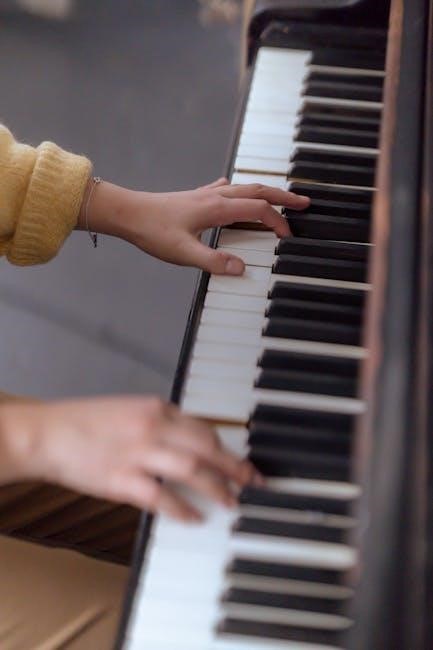
Additional Themes
- The Role of Ancestors: The piano embodies the family’s history, with carvings of ancestors, highlighting their enduring influence on the present.
- Economic Struggles: Boy Willie’s desire to sell the piano reflects the clash between preserving heritage and seeking economic stability in a harsh world.
- Gender Roles: Berniece’s strength and independence contrast with traditional expectations, illustrating the evolving roles of women in African American families during the 1930s.
The Role of Ancestors
The piano in August Wilson’s The Piano Lesson serves as a tangible connection to the Charles family’s ancestors, whose images are carved into its surface. These carvings symbolize the family’s history and cultural identity, making the piano a sacred object that transcends its physical form. The ancestors’ presence is deeply felt throughout the play, influencing the characters’ decisions and shaping their understanding of themselves. Boy Willie’s desire to sell the piano represents a break from the past, while Berniece’s insistence on keeping it reflects a commitment to preserving their ancestral legacy. The piano becomes a medium through which the ancestors’ spirits communicate, emphasizing their enduring influence on the family’s present and future. This duality underscores the struggle to honor heritage while pursuing progress.
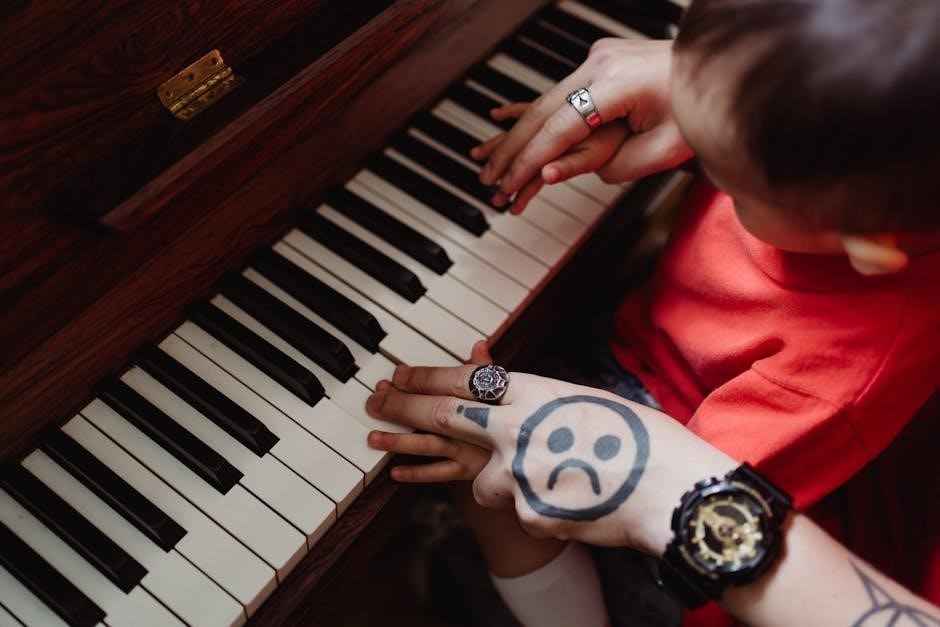
Economic Struggles
Economic struggles are a pervasive theme in The Piano Lesson, reflecting the financial hardships faced by African Americans during the 1930s. Boy Willie’s determination to sell the family piano stems from his desire to purchase land, symbolizing economic freedom and escape from poverty. The piano, as a valuable asset, represents a potential lifeline for his future. However, Berniece’s resistance highlights the tension between economic aspirations and cultural preservation. Wilson portrays the characters’ financial realities, emphasizing how economic decisions are intertwined with identity and heritage. The play underscores the broader societal challenges of racial inequality and limited opportunities, which shape the characters’ choices and aspirations. This struggle mirrors the economic disparities faced by many African American families during the Great Depression era.
Gender Roles
Gender roles in The Piano Lesson are explored through the contrasting perspectives of Berniece and Boy Willie. Berniece embodies traditional maternal and cultural preservation roles, fiercely safeguarding the piano as a symbol of their heritage. Her resistance to selling the piano reflects her commitment to upholding familial and cultural values. Conversely, Boy Willie represents a more assertive, masculine-driven approach, prioritizing economic progress over cultural preservation. The tension between them highlights the gendered division of responsibilities and aspirations within the family. Wilson’s portrayal of these roles underscores the societal expectations placed on men and women, particularly within African American communities during the 1930s. The play examines how gender influences decisions about identity, family, and economic survival. This dynamic adds depth to the broader themes of heritage and progress.